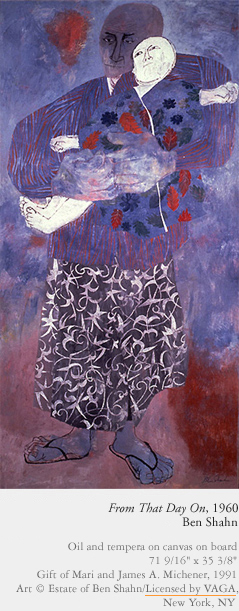Materials:
Computers with internet access
Internet sources or books and encyclopediason
WWII and atomic bomb testing and the Lucky Dragon
Poster or computer
image of Ben Shahn’s From That Day On (Click
here to order poster.)
Haiku poem template
Haiku rubric (optional)
Procedure:
- Show students a poster or computer image of Ben Shahn’s From That
Day On. Have them observe and lead them in a discussion of the artwork
by asking:
- Describe the people in the painting. What are they wearing?
- What does this say about the time and place in which they live?
- Describe their facial features, gestures, and body language.
- What is their relationship? Based on his expression and pose, how do you
think the man feels towards the child?
- What do you notice about the scale and color of the man’s hands?
- What else do you see in the background? What do you think is the meaning
of this image?
- Describe the lines in this painting. How are the lines used decoratively?
- What effect do the patterns in the clothing have on the composition?
- What are the main colors used? What associations do you make with these
colors? What sort of mood do these colors imply?
- What is the effect of the artist using white in certain areas?
- Why do you think the artist used a more abstract style instead of a more
realistic style of painting?
- Using the provided summary tell the story of the Lucky Dragon and
discuss with students the connections between the artwork and the historical
event. Have them reflect on how that information has altered their perception
of the painting:
- How has your impression of the painting changed now that you know about the
historical events surrounding it?
- How do the symbols, colors, patterns, and the treatment of the figures in
the painting fit together to tell the story of the two figures?
- Was Shahn successful
in encouraging a sense of empathy for human suffering? Why or why not?
- To connect Shahn's work to the larger historical issues, discuss with students
the development and use of the atomic bomb in Japan and the end of and following
WWII. Include in this discussion the impact of the atomic bomb, the scale of
destruction it caused, Truman's reasoning for dropping the bomb, and the lives
lost in Hiroshima and Nagasaki. If possible, share a first-hand account of
a survivor <http://www.inicom.com/hibakusha/> to
help students understand how damaging the atomic bomb was to the political,
economic, and emotional state of Japan and the Japanese people. Explain to
students that atomic bomb testing continued near Japan after WWII.
Note: You
may wish to assign reading from their textbook on Hiroshima and Nagasaki the
night before this lesson.
- Explain to students that they will conduct a mini-search on the computer
for the conditions surrounding atomic bombing and testing during and following
WWII by using internet resources or their textbooks and books. Instruct students
log onto the Blanton website search the listed sites for relevant information
by going to:
eLearning > Learning Activities > Learning Empathy
through Art > The Artwork in Context
or < http://www.blantonmuseum.org/elearning/aac/student.html>
Allow them 30 minutes to find the answers to the following:
- What circumstances led President Truman to make the decision to use the
bomb in Japan?
- Why did the U.S. continue testing bombs in Japan?
- How did the U.S. help Japan recover from the devastation of atomic war?
- Describe the physical and emotional impact of the atomic bomb on the Japanese
people.
- Next, have students get into groups of 4 or 5 to discuss their research. Each
person in the group should share 3 to 5 minutes of information and then allow
other students to voice their personal reactions to the findings.
- Tell students that they will respond to the painting and their new knowledge
of atomic bomb testing. Have them either in groups or independently log onto
the Blanton website and have them choose:
eLearning > Learning Activities > Learning Empathy
through Art > Respond and Create
or < http://www.blantonmuseum.org/elearning/aac/student.html>
Ask students to brainstorm words and phrases about the artwork and to follow
the website’s instructions which will result in them writing a haiku.
Students may either print or email their poem to themselves, the teacher, or
another person when finished.
- Invite students to read their poems to the class and/or compile the poems
into a class book as a memorial to the victims of atomic bomb. Have students
discuss their poems in relation to Ben Shahn's work and what they have learned
about victims of the atomic bomb.
![]()
